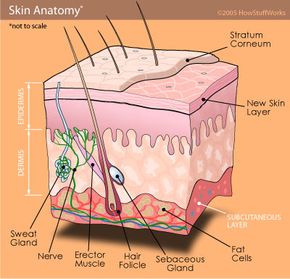Sweat Glands
Basically, the sweat gland is a long, coiled, hollow tube of cells. The coiled part in the dermis is where sweat is produced, and the long portion is a duct that connects the gland to the opening or pore on the skins's outer surface. Nerve cells from the sympathetic nervous system connect to the sweat glands. There are two types of sweat glands:
- Eccrine - the most numerous type that are found all over the body, particularly on the palms of the hands, soles of the feet and forehead
- Apocrine - mostly confined to the armpits (axilla) and the anal-genital area. They typically end in hair follicles rather than pores.
The two glands differ in size, the age that they become active and the composition of the sweat that they make. Compared to apocrine glands, eccrine glands:
Advertisement
- are smaller
- are active from birth (Apocrine glands become active only at puberty)
- produce a sweat that is free of proteins and fatty acids
In the next section, we'll find out how the glands produce sweat.
